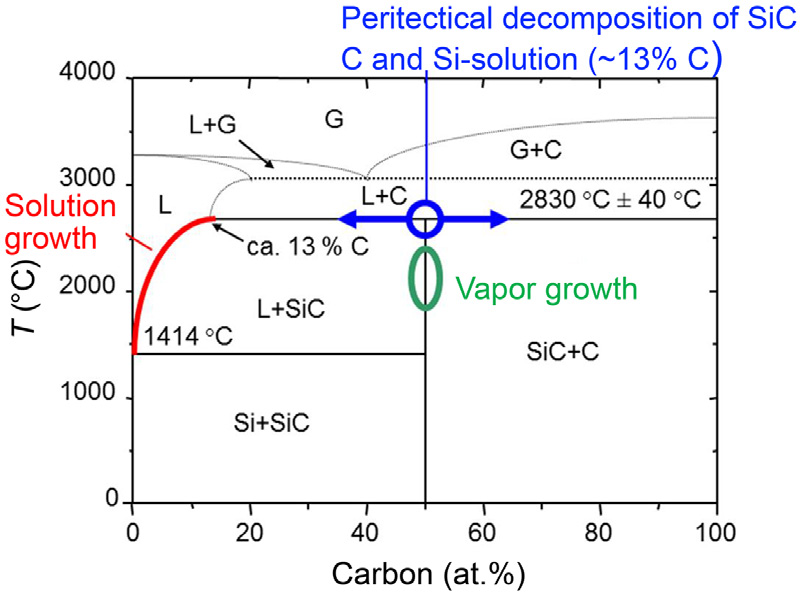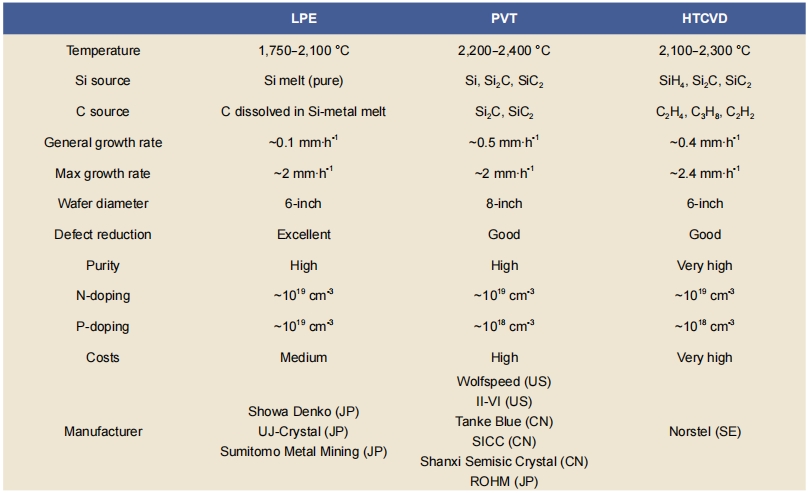As shown in Fig. 3, there are three dominant techniques aiming to provide SiC single crystal with high quality and effciency: liquid phase epitaxy (LPE), physical vapor transport (PVT), and high-temperature chemical vapor deposition (HTCVD). PVT is a well-established process for producing SiC single crystal, which is widely used in major wafer manufacturers.
However, all the three processes are rapidly evolving and innovating. It is not yet possible to aver which process will be widely adopted in the future. Particularly, high-quality SiC single crystal produced by solution growth at a considerable rate has been reported in recent years, SiC bulk growth in the liquid phase requires a lower temperature than that of the sublimation or deposition process, and it demonstrates excellence in producing P-type SiC substrates (Table 3) [33, 34].
Fig. 3: Schematic of three dominant SiC single crystal growth techniques: (a) liquid phase epitaxy; (b) physical vapor transport; (c) high-temperature chemical vapor deposition
Table 3: Comparison of LPE, PVT and HTCVD for growing SiC single crystals [33, 34]
Solution growth is a standard technology for preparing compound semiconductors [36]. Since the 1960s, researchers have attempted to develop a crystal in solution [37]. Once the technology is developed, the supersaturation of the growth surface can be well controlled, which makes the solution method a promising technology for obtaining high-quality single crystal ingots.
For solution growth of SiC single crystal, the Si source stems from highly pure Si melt while the graphite crucible serves dual purposes: heater and C solute source. SiC single crystals are more likely to grow under the ideal stoichiometric ratio when the ratio of C and Si is close to 1, indicating a lower defect density [28]. However, at atmospheric pressure, SiC shows no melting point and decomposes directly via vaporization attemperatures exceeding around 2,000 °C. SiC melts, according to theoretical expectations, can only be formed under severe be seen from the Si-C binary phase diagram (Fig. 4) that at by temperature gradient and solution system. The higher the C in the Si melt varies from 1at.% to 13at.%. The driving C supersaturation, the faster the growth rate, while low C force of the growth is the C supersaturation that is dominated pressure of 109 Pa and temperatures above 3,200 °C. It can supersaturation produces a smooth surface [22, 36-38].temperatures between 1,400 and 2,800 °C, the solubility of C in the Si melt varies from 1at.% to 13at.%. The driving force of the growth is the C supersaturation that is dominated by temperature gradient and solution system. The higher the C supersaturation, the faster the growth rate, while low C supersaturation produces a smooth surface [22, 36-38].

Fig. 4: Si-C binary phase diagram [40]
Doping transition metal elements or rare-earth elements not only effectively lower the growth temperature but seems to be the only way to drastically improve carbon solubility in Si melt. The addition of transition group metals, such as Ti [8, 14-16, 19, 40-52], Cr [29, 30, 43, 50, 53-75], Co [63, 76], Fe [77-80], etc. or rare earth metals, such as Ce [81], Y [82], Sc, etc. to the Si melt allows the carbon solubility to exceed 50at.% in a state close to thermodynamic equilibrium. Moreover, LPE technique is favorable for P-type doping of SiC, which can be achieved by alloying Al into the
solvent [50, 53, 56, 59, 64, 71-73, 82, 83]. However, the incorporation of Al leads to an increase in the resistivity of P-type SiC single crystals [49, 56].Apart from N-type growth under nitrogen doping,
solution growth generally proceeds in an inert gas atmosphere. Although helium (He) is more expensive than argon, it is favored by many scholars due to its lower viscosity and higher thermal conductivity (8 times of argon) [85]. The migration rate and Cr content in 4H-SiC are similar under He and Ar atmosphere, it is proved that growth under Heresults in a higher growth rate than growth underAr owing to the larger heat dissipation of the seed holder [68]. He impedes the voids formation inside the grown crystal and spontaneous nucleation in the solution, then, a smooth surface morphology can be obtained [86].
This paper introduced the development, applications, and properties of SiC devices, and the three main methods for growing SiC single crystal. In the following sections, the current solution growth techniques and corresponding key parameters were reviewed. Finally, an outlook was proposed that discussed the challenges and future works regarding the bulk growth of SiC single crystals via solution method.
Post time: Jul-01-2024






